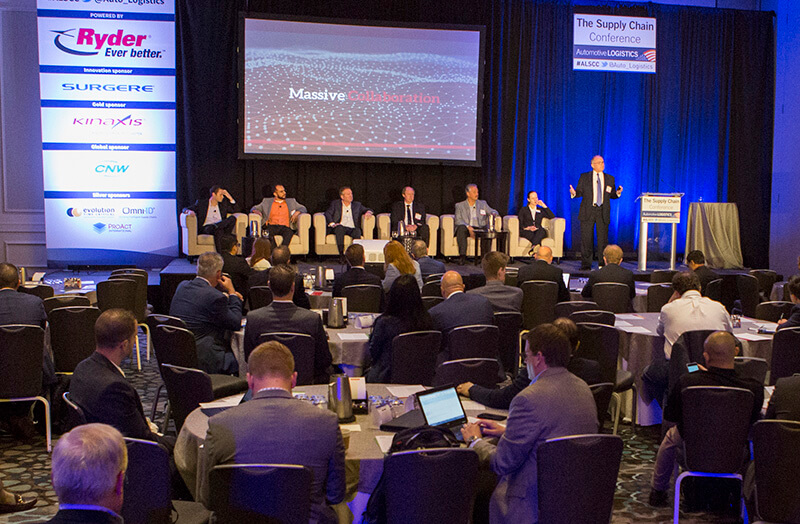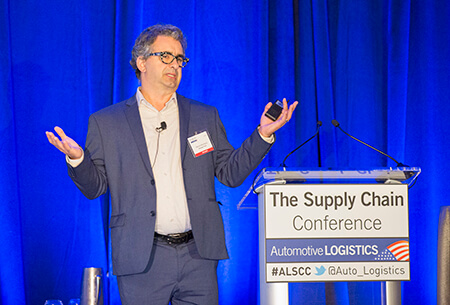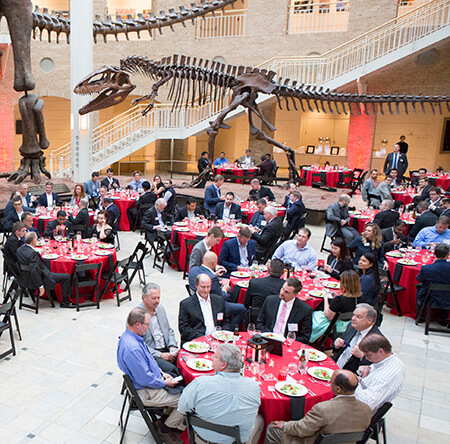 Better communication is needed in the automotive supply chain, including between OEMs, suppliers, logistics providers and IT experts providing digital supply chain services. Digital technology has a lot of answers for an industry that is making strides in addressing the needs of modern manufacturing and the changing face of mobility, but there are still gaps to fill in terms of supply chain visibility, faster asset deployment and empty backhauls.
Better communication is needed in the automotive supply chain, including between OEMs, suppliers, logistics providers and IT experts providing digital supply chain services. Digital technology has a lot of answers for an industry that is making strides in addressing the needs of modern manufacturing and the changing face of mobility, but there are still gaps to fill in terms of supply chain visibility, faster asset deployment and empty backhauls.
The automotive industry also needs to be able to respond faster to disruption in the supply chain when the inevitable unforeseen crisis hits. Other struggles include the recruitment of sufficient talent, whether managers, warehouse workers, artificial intelligence specialists or delivery drivers.
This year’s Supply Chain Conference in Atlanta, Georgia, was held alongside the inaugural automotiveIT International conference last week in an effort to promote the kind of communication and cross-fertilisation of ideas that could help to solve these issues.
Carmakers certainly continue to demand improvements in supply chain visibility and this is something that digital applications are improving on a daily basis, but according to Dana McBrien, associate chief advisor at Honda North America, the analytics are not in place to make the best use of the data gathered.

“It fascinates me to hear that we are ahead of the curve against other industries, because it feels like we are still using chisels and slate in a lot of instances,” said McBrien. “Visibility is a number one [priority], as is being able to capture data and use analytics to make decisions faster.”
Rene Deist, global chief information officer (CIO) at interiors supplier Faurecia, agreed that in a data-driven economy it was all about “the fast beating the slow”. That included not only the speed of data collection but also decisions about its worth. “We have to ask ourselves what the data is we are collecting and what the applications for it are; it is about collecting data and thinking about what value can be created out of it.”
Speeding up response timesMcBrien echoed a point made elsewhere at the conference that solutions to a supply chain problem need to be instantaneous, adding that while Honda had worked with logistics providers to close most of its blind spots, there remained issues on a granular level where it needed to act faster.
“You don’t want to know what happened yesterday – by that time, it is too late – you want to know what happened 30 seconds ago,” he said. “If you have a supply chain that is five days long you don’t want to wait until tomorrow until you execute [the solution] because it might take five days before you get it executed.”
For Paulo Monteiro, inbound logistics manager at VW of America (VWoA), the supply chain visibility question was especially pertinent: a strike at the US-Mexico border during the week of the conference led to a ten-mile truck jam and a supply dilemma for VW’s inbound parts, which kept him away from the first day of discussions in Atlanta.
“There is big pressure on each of us here if a line goes down,” said Monteiro. “There are thousands of dollars in losses because of it that we can’t afford. When we run an operation that is lean and have a disruption on that supply chain, either you have the IT tools to manage it so you can quickly react or the result is a line stoppage.”
VWoA was able to source identical material from an alternative supplier in a different country and rapidly set up another supply chain. However, the situation demonstrated the importance of timely information and responses, especially for a company running inbound parts from Mexico to Chattanooga, Tennessee, on a two-day supply window.
 Paulo Monteiro, inbound logistics manager at VW of America
Paulo Monteiro, inbound logistics manager at VW of AmericaMonteiro said the problem was solved only because of the agility of the people working in VW’s supply chain and the IT tools at its disposal. He added that VWoA was continuing to work collaboratively with its IT providers on a project to increase efficiency, add value to the supply chain and reduce costs.
Digging into the data mountainGiven the amount of technology being developed, finding what is most useful to the carmaker in a given situation is another question, and delegates were polled on who should be responsible for delivering IT solutions: 45% believed the onus on finding solutions lay with the third-party logistics provider (3PL), with 27% saying it was the IT companies. Only 15% suggested it was down to the vehicle-makers themselves to find the best technology.
This was something that Honda’s McBrien agreed with, and he said that open dialogue with 3PLs had always helped in finding the right solution to a supply chain problem. “They are doing the execution of our networks, they understand what our conditions are and what are some of the problems,” he said. “We do rely on them because they have a broader base of customers, but I always encourage them not to just use automotive [solutions].”
This point was picked up by Shoukat Ali Bhamani, vice-president, CIO and chief digital officer at Schaeffler Group America. Bhamani said his company was always looking for solutions from other industries and that his membership of a number of CIO groups helped him to be aware of the alternatives.
“Definitely, manufacturing, supply chain and logistics give us a good insight no matter what sort of business it is,” said Bhamani, adding that everyone was looking at Amazon as an example. “It’s a very basic and integral part of our thinking to look for the best solution regardless of where it is found.”
Turning to academiaTechnical universities are also a good a source of support in developing IT solutions to particular problems, as was made clear by Benoit Montreuil, director of the Supply Chain and Logistics Institute at Georgia Tech, which is based in Atlanta. While he acknowledged that large carmakers have resources of their own, plus access to consultants and vendors that already offer them a range of options, Montreuil said universities could take things to another level.
For example, when pushing boundaries by exploring cutting-edge technology such as blockchain and sensor technology, Montreuil’s department at Georgia Tech sets up partnerships, finds new ventures and establishes meetings with teams from vehicle-makers. One such project is with Mercedes-Benz.
 Benoit Montreuil, director of the Supply Chain and Logistics Institute, Georgia Tech
Benoit Montreuil, director of the Supply Chain and Logistics Institute, Georgia Tech“Mercedes sends a team and we are arranging for them to meet some of the ventures every time they come in,” explained Montreuil. “Last month they met four companies and each one pitched an idea. There were discussions and we worked with them to select the ventures that fit the most with their needs. From that, Mercedes got some pretty slick ideas that they didn't have before.”
According to McBrien, Honda is also working with Ohio State University on supply chain activity, something he said was typically driven by the establishment of supply chain teams.
Technology according to needHowever, new technology should not be thrown at a problem for the sake of it. Tony Minyon, senior manager of strategic resources at Toyota Motor NA, said that a carmaker should first identify what problem actually needed solving and ask whether a new system would add value for the customer. “A lot of times we go for that ‘shiny’ object and we are trying to put ‘flash’ into the operations but, if it is not solving a problem, you need to rethink that,” he said.
The IT system being adopted must also support the expertise of the company. “You cannot give up your core competencies,” said Minyon, explaining that the Toyota Production System was based on principles such as lean, just-in-time (JIT) and kaizenthat would never be relinquished for the sake of adopting different IT systems. “We are not going to give that up just to have a shiny new system,” he said.
By contrast, Rene Deist at Faurecia said that the creation of digital services alongside a product dictated radical changes to the very organisation of a company: “If you would like to create the new products together with digital teams, you need to suddenly provide platforms and frameworks in which people with no code programming might have to create the first MVP [minimum viable product], for instance.”
Deist predicted that in three to five years, every employee at Faurecia – currently 100,000 people – would be working in IT to some extent.
[mpu_ad]The impact of new mobilityA need for IT solutions is not only changing the strategic and organisational culture at manufacturers but transforming society as a whole, and the movement toward new mobility choices is having an impact on logistics service providers.
Shared ownership of vehicles, rental and ‘fractional ownership’ schemes, and the global growth of app-based ride-hailing services are all shifting the traditional idea of vehicle ownership towards something more like fleet ownership. That is having an effect on the automotive supply chain, with significant consequences for aftermarket sales and services.
According to VWoA’s Anu Goel, executive vice-president, group aftersales and services, Uber, Lyft and Google will be buying 5m vehicles a year, about a third of the market, over the next few years. Volvo has already sold 24,000 new XC90s to Uber, which is converting them to run as autonomous vehicles (AVs) for ride-hailing services; Jaguar Land Rover has sold 20,000 of the Jaguar I-Pace to Waymo for fleet use; and Lyft claims to have taken 250,000 cars off the road since it started operations. Eric Jillard, head of automotive industry at the World Economic Forum, pointed out that ride hailing is enabled by a new technology industry that will be worth an estimated $276 billion by 2025.
The popularity of Uber and Lyft is well known, but there are also non-traditional options for subscription ownership such as Volvo Care, Porsche Passport and Book by Cadillac, which allow customers to use a car on a personal basis for short periods.
The service and logistics requirements of dealing with a fleet ownership model include a greater focus on fast and accurate aftermarket parts supply. That is because the use of the vehicle is now a revenue generator and its uptime is a priority, unlike personal ownership, when the vehicle is parked for the majority of the time.
 Nate Chenenko, manager at automotive strategy consultant Carlisle & Co
Nate Chenenko, manager at automotive strategy consultant Carlisle & Co“Fleets have an enormous focus on uptime,” said Nate Chenenko, manager at automotive strategy consultant Carlisle & Co, drawing a parallel with the trucking and airline industries. According to Chenenko, 64% of the units operating in the trucking sector that are up to seven years old are fleet owned and new truck sales to fleet have increased by 95%. When it comes to the passenger car sector, 6.8% are fleet-owned, but the fleet ownership model is growing.
In part, this is to do with the technology being put into vehicles today; AVs will start to look a lot like fleet vehicles, said Chenenko, primarily because they are so expensive.
Indeed, data from analyst PwC Autofacts suggests that the higher cost of AVs might be a barrier to growth, along with a host of other significant issues. According to Janet Onishchuk, senior associate at PwC, these include the development of infrastructure, the regulatory environment, the level of software and consumer interest.
This year’s conference highlighted several collaborations that are set to make a big difference to supply chain operations.
One was the Automotive Data Eco-System, which uses data gathered from RFID tags on returnable containers to answer to the industry-wide problem of poor management of those containers; bad visibility on container location can cause delays in production and lead companies to use expendable or non-returnable alternatives.
Honda, Toyota, GM, Nissan and Fiat Chrysler Automobiles (FCA) started working on a project last September, with 12 of their medium to large tier suppliers and digital supply chain and packaging expert Surgere, to map out the movement of containerised parts through the networkfrom the supplier through warehouses and crossdocks and all the way to the OEM.
The project has resulted in a system that carmakers and suppliers can use to maintain visibility of returnable packaging in the supply chain. The Automotive Industry Action Group is going to publish the system as a best business practice in the near future.
 Ivan Hernandez, director of Nafta transportation at DTNA
Ivan Hernandez, director of Nafta transportation at DTNAAnother example was the collaborative Spot Load Carriers Platform that DTNA has been developing with freight broker start-up Loadsmart. According to Ivan Hernandez, director of Nafta transportation at DTNA, the company was looking to increase supplier participation in the movement of spot loads by creating an app for them to do so. Hernandez said that customers were only managing Daimler Truck freight using the board 50% of the time and the average time taken to secure loads was five hours, something it wanted to improve. The company set up a challenge to find a solution within 100 days with no budget.
Working with Loadsmart, Hernandez and his team developed a solution in 80 days and cut the time taken to secure the available load from five hours to 18 minutes on average, a reduction of 94%. It also increased the carrier use of spot loads to 68% on average, and it was up to 75% in the week before the conference in Atlanta, said Hernandez.
Ryder’s vice-president and general manager of automotive, aerospace and industrial, Steve Martin, also discussed a number of solutions that his company was now using.
One was the application of Lytx cameras facing into and out of the truck cab. “That enables us to do two things – see what the driver experiences from a training and safety behaviour standpoint, and from the safety aspect, show us how we reduce risks to safety in the cab and the environment in which we operate,” he said.
According to Martin, Ryder has reduced “event situations” by about 70%, increased vehicle following distance by around 23% and decreased near misses by almost 20%. The company has been able to take operating costs down, improve safety performance and improve driver retention, he added.
That is supported by the RyderShare system, which pulls data generated by Appian, Llamasoft and Spireon software into one platform to show the end-to-end order lifecycle of how materials move through the system, indicating the best use of dedicated transport.
Martin said that by using these tools Ryder was better able to work with OEMs and suppliers to create routing and network models that were driver friendly. “This is one area we can immediately address for the short-term benefit of improving driver retention but allows us long term to create a data stream, along with the in-cab technology for the digital future,” he said. “It puts us in a position to see how we can confidently execute a leaner supply chain and take days out of the inventory cycle.”
Chenenko said it was the cost barrier to personal ownership that was pushing the industry toward a fleet-owned system. “The network scales so effectively that AVs are already being sold into the big fleets,” he said.
This transition to fleet ownership will probably result in a car sector that looks more like the truck sector; vehicles will be in use for more time and companies will have to guarantee greater uptime. “This means that the part composition may change,” said Chenenko. “If you are a tier one supplier, you may be asked to make a part that is more robust with a longer service life.”
Servicing vehicles and installing new parts costs money, including labour, and with vehicles generating revenue lost uptime is now also a cost. “It used to be a judgement about how much customer goodwill you were willing to give up to take another day to get a part to them,” said Chenenko. “Now we have a specific number on the cost per hour for uptime.”
For the logistics service providers, critical orders are more important than they ever were. Three extra hours of downtime could cost hundreds or thousands of dollars per vehicle, and over a fleet volume that could be in the tens of thousands for the aftermarket sector.
Pressure to increase inventoriesThis situation will have an impact on inventory and carmakers will have to consider paying more to store a greater volume of parts in distribution centres to ensure overnight delivery to the dealer.
“The impact on logistics is huge,” said Chenenko. “If you can’t get parts to where they need to go when they need to be there, your customer/dealer will be adding it up and telling you what it has cost them in lost uptime. If you are not prepared to make that calculation, your customer could go somewhere else to conduct their business.”
Jay Johnson, general manager of aftermarket supply chain at Daimler Trucks North America (DTNA), confirmed Chenenko’s figures and added that his company sold 60% of its vehicles to the fleet market. He said the truckmaker was now focused on the uptime side of the business in a way that it had not been in the past.
Johnson said that DTNA went through a culture change, initiating the 72-hour challenge on truck repair in 2013 because they were taking too long to repair. This time is now down to 24 hours. While fleet managers handle the easy maintenance, the overhaul work or repairs to engines or brakes all goes to DTNA’s dealer network. The company has one of the largest dealer networks across the US, supported by nine parts distribution centres, and has created a programme called Elite Support.
“The criteria to become an Elite Support dealer is determined not by the OEM but by the dealers themselves,” said Johnson. “We sit on the board and, looking at the picture before and after, you wonder how the dealerships worked before. Now they are clean and it is the same as any continuous improvement project.”
Moving from a chain to a networkImproving the supply of more robust parts will require giving better information to tier suppliers, a process that could be supported by new technologies related to industry 4.0 and blockchain.
 Sven Dharmani, global supply chain leader for the automotive sector at Ernst & Young
Sven Dharmani, global supply chain leader for the automotive sector at Ernst & YoungThe supply chain is still organised in a linear fashion, according to Sven Dharmani, global supply chain leader for the automotive sector at Ernst & Young, although there is some exchange and interaction between suppliers, OEMs and dealers. Dealer feedback on sales and demand trends takes months to properly land with the suppliers. Dharmani said the industry had to move toward thinking more of a supply network than a supply chain, which would drive radical change.
“What we will start to see in the future is simultaneous, real-time sharing of information,” he said. “It is going to happen with blockchain and Internet of Things, with advanced analytics and [the] cloud. It is going to be a combination of a lot of things and they will drive disruption in the supply chain.”
Dharmani said such technology as robotic process automation (RPA) could bring massive cost savings simply by automating cumbersome administrative tasks; he said EY itself will save $250m this year by applying RPA across its organisation and that it is currently working with automotive customers to achieve similar results.
He also said blockchain was going to redefine the way the automotive industry did business. “How do you know the sub-supplier is getting the right price that you negotiated and the part from the right suppliers?” he asked. “Blockchain creates complete transparency because the record cannot be retrospectively edited, only added to.”
Combining these solutions with others, such as automated reality and machine learning in planning, could bring a 25-30% improvement in efficiency, according to Dharmani. He said that automotive companies now needed to move away from specific projects and invest to make digital technology part of the operating model; that is the way to drive value into the supply chain, designing processes to be agile and responsive.
 Technology solutions are only as good as the people that are using them, and various companies at this year’s conference spoke about the need for new talent. In addition, 42% of delegates polled said that human resources and talent would be the biggest challenge in developing supply chain organisations in the future.
Technology solutions are only as good as the people that are using them, and various companies at this year’s conference spoke about the need for new talent. In addition, 42% of delegates polled said that human resources and talent would be the biggest challenge in developing supply chain organisations in the future.
DTNA’s Jay Johnson said that his company had seen a 75% turnover in staff over the last five to six years and that the company was partnering with technical universities and other institutions in the search for new recruits.
Paulo Monteiro, inbound logistics manager at VWoA, pointed out that the unemployment rate in Hamilton county, where VW's Chattanooga plant is located, is just 3.2% and that it is similarly below 4% in Tennessee. Monteiro said he had lost good talent to competition as a consequence of the fight for talented workers.
“The resources are just not there,” he said. “We are growing economically and the good thing is that the salaries may increase, but we have a big struggle in terms of the availability of either blue or white-collar workers.”
Monteiro said that, if it was possible to do the same work with less manpower by using IT, then that was the goal in every process across the supply chain to combat the current threat to recruitment.
Honda’s McBrien noted that both blue and white-collar workers were now hard to come by and that it was perhaps a case of using IT to carry out tasks in a way that enabled “millennial” workers to have the 08.00-17.00 day they wanted. McBrien said it was the job of companies to develop interest in the manufacturing process and an understanding of the product that went beyond simple manual labour.
Schaeffler's Bhamani agreed that talent was scarce, especially in the field of new technologies, such as artificial intelligence (AI). “There are not that many resources out there to be captured and it is a real challenge,” he said. “But if you had all the technological resources available to your company, I'm not sure how much you could do with them if you didn’t have the business knowledge.”
Bhamani said Schaeffler's strategy was to recruit talent from outside the industry to guide the company in the technological direction in which it needed to go, but there was a move at the same time to free up resources internally and train people in the relevant technology.
Benoit Montreuil suggested introducing greater automation and then challenging a new generation of people – the so-called ‘digital natives’ – by engaging them with non-didactic tasks.
One particularly pressing problem at the moment is driver retention, both on the inbound and outbound side of the automotive business. Monteiro said that the transport industry updates he received from XPO Logistics every month indicated that in two to three years the industry would run out of drivers altogether. He went on to ask whether IT could help here.
Polled delegates felt it was in the commercial sector that automated vehicle technology would have the biggest impact and that companies were looking to truck platooning on long-haul routes as one possible means to address the problem.
Others including Montreuil said that, while it was often the long-haul aspect of trucking that put people off choosing it as a career, a relay system of switching trailers at 200-mile distances could be an alternative to pinning hopes on AVs.
The Supply Chain conference is part of the global Automotive Logistics series of conferences.
The next conference, Automotive Logistics Europe, will be held on June 13-14 in Bonn, Germany, following the inaugural Automotive Logistics Awards – Europe 2018 on June 12.


























![Global[1]](https://d3n5uof8vony13.cloudfront.net/Pictures/web/a/d/s/global1_726550.svgz)
















